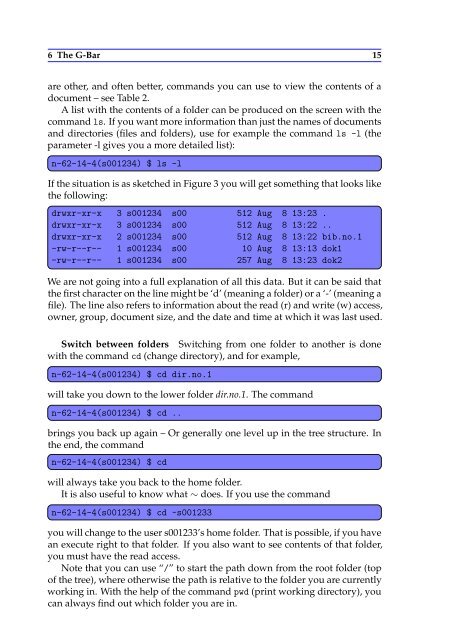Create successful ePaper yourself
Turn your PDF publications into a flip-book with our unique Google optimized e-Paper software.
6 <strong>The</strong> G-<strong>Bar</strong> 15<br />
are other, and often better, commands you can use to view the contents of a<br />
document – see Table 2.<br />
A list with the contents of a folder can be produced on the screen with the<br />
command ls. If you want more inform<strong>at</strong>ion than just the names of documents<br />
and directories (files and folders), use for example the command ls -l (the<br />
parameter -l gives you a more detailed list):<br />
n-62-14-4(s001234) $ ls -l<br />
If the situ<strong>at</strong>ion is as sketched in Figure 3 you will get something th<strong>at</strong> looks like<br />
the following:<br />
drwxr-xr-x 3 s001234 s00 512 Aug 8 13:23 .<br />
drwxr-xr-x 3 s001234 s00 512 Aug 8 13:22 ..<br />
drwxr-xr-x 2 s001234 s00 512 Aug 8 13:22 bib.no.1<br />
-rw-r--r-- 1 s001234 s00 10 Aug 8 13:13 dok1<br />
-rw-r--r-- 1 s001234 s00 257 Aug 8 13:23 dok2<br />
We are not going into a full explan<strong>at</strong>ion of all this d<strong>at</strong>a. But it can be said th<strong>at</strong><br />
the first character on the line might be ‘d’ (meaning a folder) or a ‘-’ (meaning a<br />
file). <strong>The</strong> line also refers to inform<strong>at</strong>ion about the read (r) and write (w) access,<br />
owner, group, document size, and the d<strong>at</strong>e and time <strong>at</strong> which it was last used.<br />
Switch between folders Switching from one folder to another is done<br />
with the command cd (change directory), and for example,<br />
n-62-14-4(s001234) $ cd dir.no.1<br />
will take you down to the lower folder dir.no.1. <strong>The</strong> command<br />
n-62-14-4(s001234) $ cd ..<br />
brings you back up again – Or generally one level up in the tree structure. In<br />
the end, the command<br />
n-62-14-4(s001234) $ cd<br />
will always take you back to the home folder.<br />
It is also useful to know wh<strong>at</strong> ∼ does. If you use the command<br />
n-62-14-4(s001234) $ cd ~s001233<br />
you will change to the user s001233’s home folder. Th<strong>at</strong> is possible, if you have<br />
an execute right to th<strong>at</strong> folder. If you also want to see contents of th<strong>at</strong> folder,<br />
you must have the read access.<br />
Note th<strong>at</strong> you can use “/” to start the p<strong>at</strong>h down from the root folder (top<br />
of the tree), where otherwise the p<strong>at</strong>h is rel<strong>at</strong>ive to the folder you are currently<br />
working in. With the help of the command pwd (print working directory), you<br />
can always find out which folder you are in.








